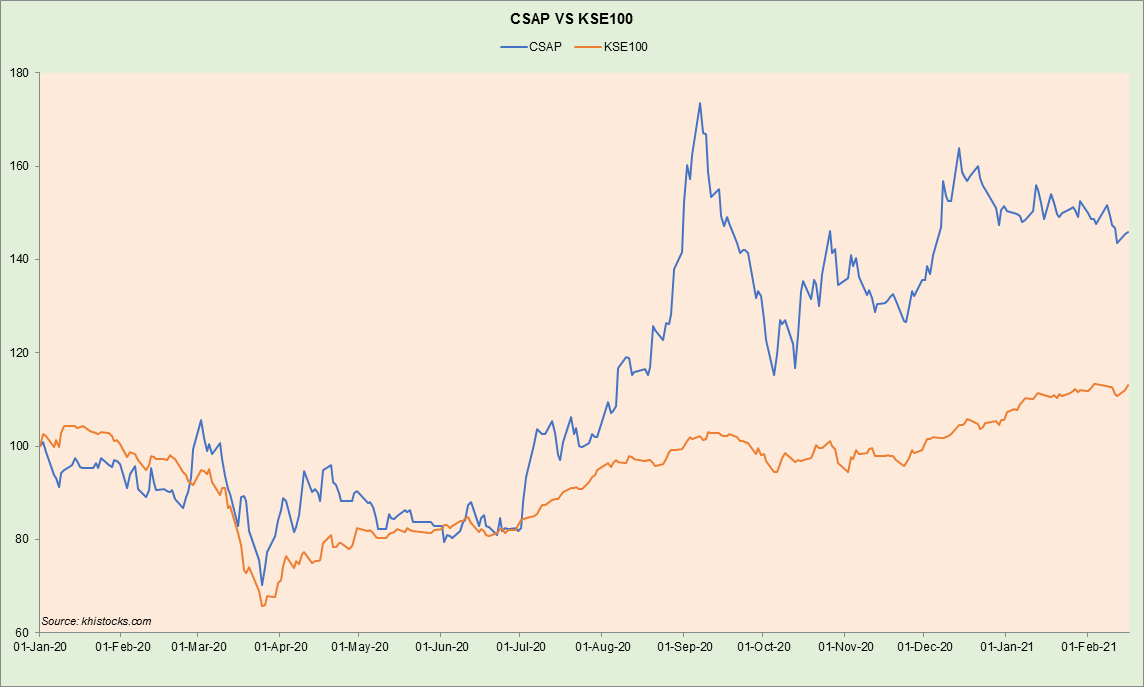Crescent Steel and Allied Products Limited
Crescent Steel and Allied Products Limited (PSX: CSAP) was set up as a public limited company in 1983 under the Companies Act, 1913 (now, Companies Act, 2017). The company has four primary divisions in which it operates: steel, cotton, investment and infrastructure development (IID), and energy segment.
Shareholding pattern
As at June 30, 2020, about 19.4 percent shares were held in “other companies (local and foreign)”, while similar shareholding was also held under associated companies, undertakings and related parties. Within this category, the largest shareholder was The Crescent Textile Mills Limited owning 11 percent shares. Close to 40 percent shares are with the local general public, while the directors, CEO, their spouses and minor children own less than 2 percent shares. Of this, close to 1 percent shares are held by the CEO, Mr. Ahsan Muhammad Saleem and his spouse Mrs. Shahnaz A. Saleem; some 13 percent shares are held in banks, DFIs, and NBFCs. The remaining about 9 percent shares is distributed with the rest of the shareholder categories.

Historical operational performance
Crescent Steel’s topline and profit margins, both have been fluctuating for the past decade.

During FY17, the company saw topline growth of almost 38 percent, with over Rs10 billion in sales. Of this, nearly Rs9 billion were derived from the steel segment; sales of the same in value terms exhibited an increase of almost 21 percent. However, this did not translate into higher margins due to prices of Hot Rolled Steel Coils moving upwards, combined with lower revenue from coating activities. Gross margin for FY17 was recorded at close to 21 percent, whereas during FY16 it was nearly 31 percent. Collectively (includes IID segment and cotton segment in addition to the steel segment), too, gross margin was lower at 18 percent, compared to almost 29 percent in FY16. However, the drop in net margin recorded at almost 10 percent (FY18: 13 percent) was not as pronounced due to notable support from other income and income from investments.
In FY18, revenue went down significantly by 31 percent; of the Rs7 billion net sales, a little over Rs 6 billion came from the steel segment. The steel business also saw a drop in sales by 31 percent. This was attributed to a slowdown in the pace of projects due to instability in the government as the year ended with general elections. Prices of HRC were also volatile and increased by 7 percent during the year. Thus, for the steel division, gross margin was lower at almost 13 percent, whereas collectively too, gross margin shrunk to 11.5 percent. However, it was income from investments that were substantial year on year, at Rs 496 million, that led net margin to increase to 10.7 percent, despite overall cost of production exceeding 88 percent (FY17: 81.79 percent).

Crescent Steel saw revenue contracting by a little over 42 percent in FY19. The steel division, that made up almost 60 percent of the total revenue, also saw a contraction in revenue by 61 percent. Prices for HRC were again volatile and went up by 12.5 percent during the year. Moreover, “pipe plant remained mostly idle throughout the year due to delays in approval and execution of line pipe projects by the government”. Therefore, for the steel division gross margins were lower at almost 5 percent, while collectively gross margin shrunk to 5.4 percent. Cost of production overall was near 95 percent of revenue. “Other income” and investment income were lower than that seen in the previous year. Therefore, the lower gross margin also translated into a lower net margin of 3.5 percent.

Fall in revenue was relatively contained at 6 percent, compared to the double-digit decline seen in the last two consecutive years. Revenue for steel division was down by 46 percent and made up nearly 34 percent of revenue. Cost of production overall, at 99 percent consumed nearly the entire revenue. For the steel division gross margin stood at 2.6 percent due to low order intakes, while overall it was 1.3 percent. Total administration and finance expense went up to make 6.4 and 8 percent of revenue. The former was due to increase in salaries expense, while the latter was a result of higher interest expense on non-shariah arrangement for running finances. Although investment income was notable, it could not keep the company from posting a loss, that stood at Rs17 million.
Quarterly results and future outlook
Revenue more than doubled during 1HFY21 year on year. A breakdown for each segment is not known, however, cost of production was significantly lower at 87 percent of revenue, compared to costs exceeding revenue same time last year. Therefore, gross margin was also higher in 1HFY21 while net margin, at nearly 19 percent was notably supported by other income and “share of profit in equity accounted investees”, with the latter recorded at Rs 393 million.

While the pandemic had brought the world to a halt, it also helped that the policy rates were reduced that made cost of funds for business easy. Moreover, while various projects are increasing demand for line pipes, its effect will be seen in the long run. The company also sees demand for rebars and billets improving “on the back of the relief package announced for construction industries as well as ongoing CPEC projects”.
























Comments
Comments are closed.